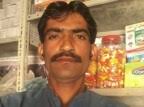Zabad Baiyan, a 25 years old medical dispenser, father of two little ones is abducted from main bazaar of Awaran Balochistan in front of all the public on 1st of August 2016. Everybody saw the Army vehicles, which approached him straightly. The military men tied his hands on back, blindfolded and took him in their vehicle. Family is still kept unaware of his whereabouts and the charges.
“We fear his fate. He will be treated as Umar and Nasir were”, said his family, referring to two of his brothers, Omar, the eldest brother and Nasir the youngest who were picked up by security forces on October 04, 2013, in the same bazaar and same way in front of all the public.
Later on, Nasir’s dead body was found in the mass graves of Khuzdar, Balochistan in January 2014, where hundreds of the dead bodies were dumped. Most of the dead bodies were unrecognizable, but Nasir’s was identified as his NIC was kept along with the dead body and the sticker of Tailor’s shop was still recognizable, from where Nasir used to get his dresses stitched.
It seems that Security forces of Pakistan do not count any rule and law and human rights in Balochistan. Abductions are very high. The matters of extra judicial and custodial killings are not even being raised and enquired properly by international media and human rights organizations.


